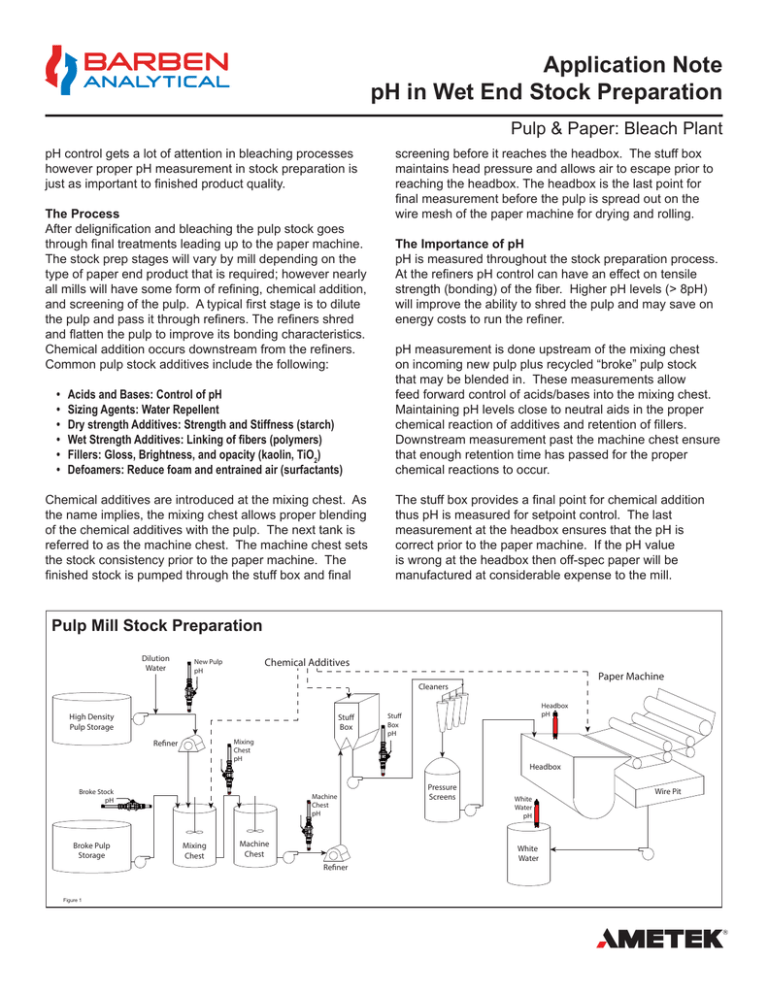
Application Note
pH in Wet End Stock Preparation
Pulp & Paper: Bleach Plant
pH control gets a lot of attention in bleaching processes
however proper pH measurement in stock preparation is
just as important to finished product quality.
The Process
After delignification and bleaching the pulp stock goes
through final treatments leading up to the paper machine.
The stock prep stages will vary by mill depending on the
type of paper end product that is required; however nearly
all mills will have some form of refining, chemical addition,
and screening of the pulp. A typical first stage is to dilute
the pulp and pass it through refiners. The refiners shred
and flatten the pulp to improve its bonding characteristics.
Chemical addition occurs downstream from the refiners.
Common pulp stock additives include the following:
•
•
•
•
•
•
Acids and Bases: Control of pH
Sizing Agents: Water Repellent
Dry strength Additives: Strength and Stiffness (starch)
Wet Strength Additives: Linking of fibers (polymers)
Fillers: Gloss, Brightness, and opacity (kaolin, TiO2)
Defoamers: Reduce foam and entrained air (surfactants)
Chemical additives are introduced at the mixing chest. As
the name implies, the mixing chest allows proper blending
of the chemical additives with the pulp. The next tank is
referred to as the machine chest. The machine chest sets
the stock consistency prior to the paper machine. The
finished stock is pumped through the stuff box and final
screening before it reaches the headbox. The stuff box
maintains head pressure and allows air to escape prior to
reaching the headbox. The headbox is the last point for
final measurement before the pulp is spread out on the
wire mesh of the paper machine for drying and rolling.
The Importance of pH
pH is measured throughout the stock preparation process.
At the refiners pH control can have an effect on tensile
strength (bonding) of the fiber. Higher pH levels (> 8pH)
will improve the ability to shred the pulp and may save on
energy costs to run the refiner.
pH measurement is done upstream of the mixing chest
on incoming new pulp plus recycled “broke” pulp stock
that may be blended in. These measurements allow
feed forward control of acids/bases into the mixing chest.
Maintaining pH levels close to neutral aids in the proper
chemical reaction of additives and retention of fillers.
Downstream measurement past the machine chest ensure
that enough retention time has passed for the proper
chemical reactions to occur.
The stuff box provides a final point for chemical addition
thus pH is measured for setpoint control. The last
measurement at the headbox ensures that the pH is
correct prior to the paper machine. If the pH value
is wrong at the headbox then off-spec paper will be
manufactured at considerable expense to the mill.
Pulp Mill Stock Preparation
Dilution
Water
Chemical Additives
New Pulp
pH
Paper Machine
Cleaners
High Density
Pulp Storage
Stuff
Box
Headbox
pH
Stuff
Box
pH
Mixing
Chest
pH
Refiner
Headbox
Broke Stock
pH
Broke Pulp
Storage
Machine
Chest
pH
Mixing
Chest
Machine
Chest
Wire Pit
White
Water
pH
White
Water
Refiner
Figure 1
Pressure
Screens
Application Note
pH in Wet End Stock Preparation
Solutions
pH measurement in stock preparation areas can prove
challenging. The pulp stock can be abrasive to the glass
electrode. For applications where the stock consistency
exceeds 12% abrasion becomes problematic; thus Barben
Analytical recommends our “CF” flat glass coat resistant
electrodes. Our standard hemispherical “R” and “CR”
glass electrodes are well suited for lower stock consistency
applications below 12%.
Some additives such as colloidal silica (SiO2) and
defoamers can also cause measurement problems. SiO2
aids in the dewatering of the pulp stock. It can also bond
to the glass pH electrode thus hindering the measurement.
The solution for silica coating is Barben’s “HR” and “FH”
Silica resistant glass electrodes. These electrodes receive
a special Nafion barrier that prevents silica coatings from
occurring.
Defoaming chemicals can penetrate the reference of
the pH sensor causing noisy readings and eventual
loss of signal. The Barben Axial Ion Path® reference
design provides highly effective against the clogging
effects of defoamers. The reference consists of a large
surface area Teflon interface followed by internal filtering
chambers. The large surface area makes plugging much
more difficult. The wood filtering chambers help to slow
chemical penetration over time.
For measurements in the headbox, chests, and tanks
the Barben 546 threaded sensor is a good choice. This
sensor uses 3/4” male NPT threads on both the front and
rear of the sensor body thus providing some versatility on
how it will be mounted.
Barben pH sensors will easily connect to most analyzers
in use today, Wiring diagrams for commonly available
instruments can be found on www.BarbenAnalytical.com
or via request from technical support.
Installation Examples
547 retractable pH
Sensor mounted on
side of vertical pipeline
Figure 2
Multiple Axial Ion Paths
Plug free communication
Seal individual filtering chambers
Annular Filtering Junction
Maintains measurement signal
Wood slows process ingress
Highly resistant to strong chemicals
546 pH Sensor
mounted on dip tube
into a vessel
Teflon Junction Interface
H+
H+
Initial protection against process
Large surface area
H+
H+
H
+
H+
H+
H+
ION PATH®
The illustration on the proceeding page shows two styles
of Barben Performance Series pH sensors. For installation
in pipelines the Barben 547 cartridge style pH sensor is
highly recommended. The 547 sensor is a retractable
“hot tap” design for installation directly into the process.
The electrode tip should protrude at least 1/2” beyond the
inside pipe wall to ensure that there is adequate flow past
the sensor.
Figure 3
Barben Analytical reserves the right to make technical changes or modify the contents of this
document without prior notice. We reserve all rights in this document and in the subject matter
and illustrations contained within.
Kynar® is a registered trademark of Elf Atochem North America Inc.
NafionTM is a registered trademark of DuPont, Inc.
© 2015, by AMETEK, Inc. All rights reserved • Bleach_Plant_AN_RevA • August, 2015
USA • BELGIUM • CHINA • SINGAPORE
Toll Free +1(800)993-9309 • Phone +1(775)883-2500 • Fax +1(775)297-4740
Sales.Barben@Ametek.com • www.BarbenAnalytical.com
ISO 9001:2008
Cert. No. 43271




